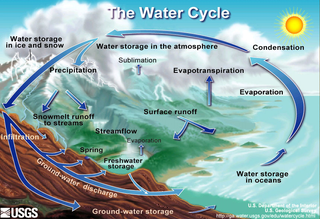Chemical cycling

Chemical cycling describes systems of repeated circulation of chemicals between other compounds, states and materials, and back to their original state, that occurs in space, and on many objects in space including the Earth. Active chemical cycling is known to occur in stars, many planets and natural satellites.
Chemical cycling plays a large role in sustaining planetary atmospheres, liquids and biological processes and can greatly influence weather and climate. Some chemical cycles release
The Sun, other stars and star systems
In most hydrogen-fusing stars, including the Sun, a chemical cycle involved in stellar nucleosynthesis occurs which is known as a carbon-nitrogen-oxygen or (CNO cycle). In addition to this cycle, stars also have a helium cycle.[1] Various cycles involving gas and dust have been found to occur in galaxies.[2]
Venus
The majority of known chemical cycles on Venus involve its dense atmosphere and compounds of carbon and sulphur, the most significant being a strong carbon dioxide cycle.[3] The lack of a complete carbon cycle including a geochemical carbon cycle, for example, is thought to be a cause of its runaway greenhouse effect, due to the lack of a substantial carbon sink.[4] Sulphur cycles including sulphur oxide cycles also occur, sulphur oxide in the upper atmosphere and results in the presence of sulfuric acid[5] in turn returns to oxides through photolysis.[6] Indications also suggest an ozone cycle on Venus similar to that of Earth's.[7]
Earth

A number of different types of chemical cycles geochemical cycles occur on Earth. Biogeochemical cycles play an important role in sustaining the biosphere. Notable active chemical cycles on Earth include:
- Carbon cycle – consisting of an atmospheric carbon cycle (and carbon dioxide cycle), terrestrial biological carbon cycle, oceanic carbon cycle and geological carbon cycle
- ammonification, nitrification, and denitrification
- Oxygen cycle and Ozone–oxygen cycle – a biogeochemical cycle of circulating oxygen between the atmosphere, biosphere (the global sum of all ecosystems), and the lithosphere
- Ozone-oxygen cycle – continually regenerates ozone in the atmosphere and converts ultraviolet radiation(UV) into heat
- Water cycle – moves water continuously on, above and below the surface shifting between states of liquid, solution, ice and vapour
- Methane cycle– moves methane between geological and biogeochemical sources and reactions in the atmosphere
- Hydrogen cycle – a biogeochemical cycle brought about by a combination of biological and abiological processes
- Phosphorus cycle – the movement of phosphorus through the lithosphere, hydrosphere, and biosphere
- Sulfur cycle – a biogeochemical process resulting form the mineralization of organic sulfur, oxidation, reduction and incorporation into organic compounds
- Carbonate–silicate cycle transforms silicate rocks to carbonate rocks by weathering and sedimentation and transforms carbonate rocks back into silicates by metamorphism and magmatism.[8]
- Rock cycle – switches rock between its three forms: sedimentary, metamorphic, and igneous
- Mercury cycle – a biogeochemical process in which naturally occurring mercury is bioaccumulated before recombining with sulfur and returning to geological sources as sediments
Other chemical cycles include hydrogen peroxide.[9]
Mars

Recent evidence suggests that similar chemical cycles to Earth's occur on a lesser scale on Mars, facilitated by the thin atmosphere, including carbon dioxide (and possibly carbon),[10] water,[11] sulphur,[12] methane,[13] oxygen,[14] ozone,[15] and nitrogen[16] cycles. Many studies point to significantly more active chemical cycles on Mars in the past, however the faint young Sun paradox has proved problematic in determining chemical cycles involved in early climate models of the planet.[17]
Jupiter

Significant chemical cycles exist on Jupiter's moons. Recent evidence points to
Saturn

In addition to Saturn's methane cycle[18] some studies suggest an ammonia cycle induced by photolysis similar to Jupiter's.[25]
The cycles of its moons are of particular interest. Observations by Cassini–Huygens of Titan's atmosphere and interactions with its liquid mantle give rise to several active chemical cycles including a methane,[26] hydrocarbon,[27] hydrogen,[28] and carbon[29] cycles. Enceladus has an active hydrological, silicate and possibly a nitrogen cycle.[30][31]
Uranus
Uranus has an active methane cycle.[32] Methane is converted to hydrocarbons through photolysis which condenses and as they are heated, release methane which rises to the upper atmosphere.
Studies by Grundy et al. (2006) indicate active carbon cycles operates on Titania, Umbriel and Ariel and Oberon through the ongoing sublimation and deposition of carbon dioxide, though some is lost to space over long periods of time.[33]
Neptune
Neptune's internal heat and convection drives cycles of methane,[18] carbon,[34] and a combination of other volatiles within Triton's lithosphere.[35]
Models predicted the presence of seasonal nitrogen cycles on the moon Triton,[36] however this has not been supported by observations to date.
Pluto-Charon system
Models predict a seasonal nitrogen cycle on Pluto[37] and observations by New Horizons appear to support this.
References
- ISBN 978-3-319-18953-6.
- ISSN 1743-9213.
- ISSN 0032-0633.
- ^ Nick Strobel. "Venus". Archived from the original on 2007-02-12. Retrieved 17 February 2009.
- S2CID 33859789.
- ISSN 1752-0894.
- ISSN 0019-1035.
- doi:10.2475/ajs.283.7.641. Archived from the original(PDF) on 2016-03-26. Retrieved Feb 3, 2015.
- ISSN 0022-4073.
- ISSN 0091-7613.
- ISSN 1942-2466.
- ISSN 1811-5209.
- ISSN 0032-0633.
- ISSN 0148-0227.
- ISSN 1752-0894.
- S2CID 40894966.
- S2CID 14765875.
- ^ ISBN 978-0-521-03545-3.
- ISSN 0019-1035.
- ISSN 1752-0894.
- PMID 16805702.
- .
- ISSN 0148-0227.
- S2CID 27378519.
- ISBN 978-1-4020-9216-9.
- ISSN 0032-0633.
- S2CID 1165160.
- ISSN 0019-1035.
- S2CID 134263911.
- ISSN 0004-6361.
- S2CID 15416810.
- ISBN 978-0-387-76602-7.
- S2CID 12105236.
- ISBN 978-0-8165-1525-7.
- ^ Steven M. Battaglia (2013). "Volatile-Lithosphere Recycling of Outer Icy Satellites and Trans-Neptunian Objects Inferred from Thermal Gradient Modeling of Triton's Ice Shell". Geological Society of America.
{{cite journal}}: Cite journal requires|journal=(help) - ISSN 0019-1035.
- ISSN 0019-1035.
